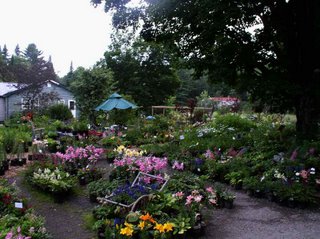 It was cold and dark this morning with the skies spitting pieces of sleet and intermittent snow flakes. I hadn't been fooled by previous weeks of warm weather and the nicer signs of spring but like many, I had hoped the mild days would continue. As I came around the corner of the lower woods road, a grouse ran through, did a half circle, took a glance my way and scooted into the balsams.
It was cold and dark this morning with the skies spitting pieces of sleet and intermittent snow flakes. I hadn't been fooled by previous weeks of warm weather and the nicer signs of spring but like many, I had hoped the mild days would continue. As I came around the corner of the lower woods road, a grouse ran through, did a half circle, took a glance my way and scooted into the balsams.I walked up the road checking for deer and moose tracks. No fresh moose tracks today but the usual deer sign showed movement from the valley floor up to our seculded fields. Recent rains have encouraged the grass to grow and although it is always a poor crop, it's the best there is in these parts this time of year.
I made it to the old barn foundation garden and as I always do, I entered the front, moving slowly and looking for signs of unfurled hosta and wildflower leaves breaking ground. Save for a few bunchberry stems, there were none. I sat on the granite bench a neighbor had made for us, and listened to the silence. The sun would be rising soon, I thought, as the birds had begun their morning chorus.
Lots of work left to get the garden ready, I thought. I had already raked the leaves off the beds and into the walkways. The accumulation of downed branches from January's storm would take time to remove. The northeast corner of the foundation wall still had a foot of ice and snow welding piles of leaves to the garden floor. It would be another week or two before they would thaw. The little display pond was ice-free but filled with leaves and twigs. Apparently, it was still too cold for the spring peepers, as the water surface didn't move.
My eyes focused on an old piece of chain I dug out of the cellar hole. Eight beautiful old links of pitted and rusted iron....left I surmise, from the days when the foundation was built. Moving large stone takes levers and rollers and pry bars, man and animal power...and sometimes even chains. I could be wrong about its use but I'm certain the bigger part of it remains a mystery, still missing....perhaps buried right here. Eight links would not have been much use except perhaps to hold a rope hoist to the barn rafters and secure a beef or pig butchered and spread on a whipple tree, hanging to drip. Chains have many uses......but eight links?
In the distance, I could hear the sound of the route driver for my Sunday paper. He's new and I haven't met him yet. His muddy truck sounds as if it is missing the muffler, perhaps another victim of mud season. I'll meet the driver sometime soon, but for now...........a cup of coffee.
Be well.
George Africa
http://vermontflowerfarm.com



